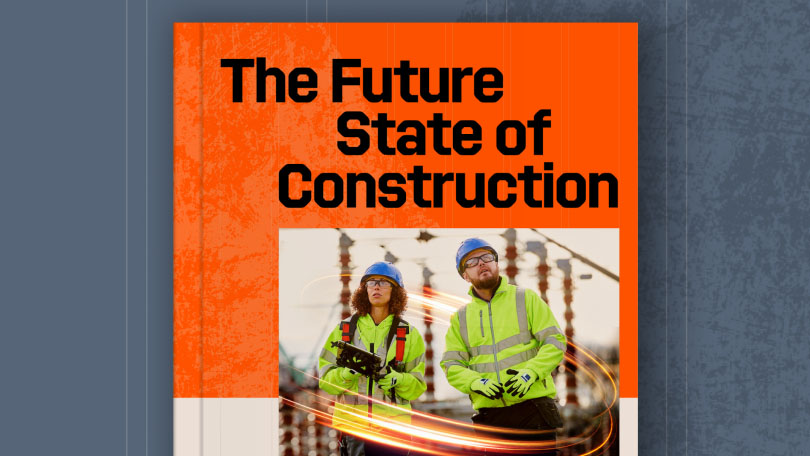— 9 min read
Why As-Built Drawings Matter in Construction


Last Updated Aug 28, 2025

Nicholas Dunbar
Content Manager
62 articles
Nick Dunbar oversees the creation and management of UK and Ireland educational content at Procore. Previously, he worked as a sustainability writer at the Building Research Establishment and served as a sustainability consultant within the built environment sector. Nick holds degrees in industrial sustainability and environmental sciences and lives in Camden, London.

Zoe Mullan
27 articles
Zoe Mullan is an experienced content writer and editor with a background in marketing and communications in the e-learning sector. Zoe holds an MA in English Literature and History from the University of Glasgow and a PGDip in Journalism from the University of Strathclyde and lives in Northern Ireland.
Last Updated Aug 28, 2025

Every construction project ends with the most accurate reflection of reality – the as-built drawing. While original plans show what should have been constructed, as-built drawings show what was actually built. Furthermore, they capture every last-minute change, on site workaround, and unexpected reroute in a final, detailed record.
Construction teams often overlook these drawings once the dust settles. However, as-built drawings are the living map of a completed project, forming the foundation for future maintenance, upgrades, and legal certainty when things go awry. Understanding their purpose and importance helps construction firms maintain accuracy, drive continuous improvement, and boost efficiency from one project to the next.
Table of contents
What are As-Built Drawings?
As-built drawings represent the final record of a construction project – a precise, updated set of drawings that reflect exactly what was built, not just the original plans. They document all deviations from the original design, including last-minute changes, substitutions, and on site adjustments made during construction.
Contractors typically prepare these drawings as the project wraps up, and they become the authoritative source of truth for what exists on the ground. Having an accurate account of the built structure proves vital throughout any building's lifecycle. From facility managers to architects revisiting the site years later, as-built drawings provide an essential reference long after the ribbon-cutting ceremony.
Alternative Terms
The construction industry uses the term "as-built drawing" widely, but depending on the project stage, region, or company practices, you might also hear these documents referred to as:
- Record drawings – emphasising their role as the final, authoritative record
- Red-line drawings – highlighting the marked-up edits made to the original plans on site
- As-constructed drawings – a straightforward term used in some regions and contracts
These terms are often used interchangeably and serve the same purpose: creating an accurate record of what was built.
What do As-Built drawings include?
As-built drawings differ from other drawings and plans because they capture the true details of each part of a project as it was constructed. They also include every physical change that occurred during the build. The following typically form the core content of as-built drawings:
- Modifications to dimensions, layouts, or positioning
- Changes to specified materials or construction methods
- Locations of installations, such as mechanical systems, electrical runs, and plumbing
- Additions or alterations made on site
- Obstructions encountered and how teams resolved them
- Extra work performed beyond the original scope
- Final, confirmed dimensions of all built components
- Field changes, shop drawing adjustments, and design updates
This level of precision proves essential for efficient maintenance, modifications, and future work that depends on knowing what's really behind the walls. Unfortunately, many projects either overlook accurate as-built drawings entirely or leave them until the very end, when field notes may go missing or important details have already been forgotten. Therefore, consistent documentation throughout the build is necessary to produce a reliable as-built record.
How As-Built Drawings Differ from Other Plans
While as-built drawings fall under construction documentation, their role is distinct from other types of drawings. Here's how they compare:
Design Drawings
These drawings are created during the planning phase and outline the original vision. They show what the building should look like, from layouts and elevations to structural and MEP systems.
These drawings guide the build. Working documents are used on site and often include updates from shop drawings, engineer inputs, or Requests for Information (RFIs).
Shop Drawings
Typically produced by subcontractors or manufacturers, these drawings focus on fine details such as steel reinforcements, joinery, or mechanical installations.
In contrast, as-built drawings document what was actually built. They incorporate all changes made during construction, whether planned or improvised, and provide the most accurate record of the final product.
While design, construction, and shop drawings represent intention and instruction, as-built drawings reflect reality, which makes them indispensable for anyone working with the building after construction is complete.
Comparing Design to Reality
One of the most powerful uses of as-built drawings is their ability to serve as a direct comparison tool, showing how the final construction differed from the original design. They document exactly what changed, why it changed, and how the changes impact the finished structure. Some of the most common comparison points include:
- Planned vs. actual dimensions, particularly where tolerances were adjusted or layouts shifted
- Changes in material locations or substitutions due to supply issues or site conditions
- Rerouted utilities, including plumbing, electrical, or HVAC systems
- On site modifications made to overcome obstructions or accommodate new requirements
- Final grading and landscape features that may differ from the original site plans
Crucially, as-built drawings don't just document the building itself. They often include the surrounding land, infrastructure, and underground utilities, offering a complete blueprint of the site as it exists today.
Why As-Built Drawings are Essential
The role of as-built drawings extends well beyond project closeout. They provide an accurate and accessible record of the building's current state – vital for anyone involved in its ongoing operation, maintenance, or future development. Without them, facilities teams would be left guessing the location of key systems, and renovation work may risk costly delays or safety issues.
Key benefits of as-built drawings include:
- Supporting future renovations and upgrades by clearly showing existing layouts and structures
- Enabling faster troubleshooting and repairs by accurately locating hidden systems, like wiring or pipework
- Reducing risk and rework by ensuring all stakeholders understand the building's actual configuration
- Strengthening asset management and lifecycle planning through up-to-date, trustworthy documentation
- Providing legal protection by offering a verified record of what was built and when
The importance of accurate as-built records has gained greater visibility in recent years and is generally now a regulatory expectation for high-risk buildings. Whether for school refurbishments, public-sector BIM projects subject to BIM Level 2 requirements, or commercial handovers, as-built drawings ensure buildings remain safe, efficient, and future-ready.
Real-World Applications and New Technologies
The accuracy and accessibility of the as-built record directly impacts cost, safety, and decision-making. Here are four common, real-world scenarios where teams apply these drawings:
Facilities Team
A facilities team needs to locate electrical wiring behind a wall to avoid damaging key systems during an office fit-out.
Architect
An architect extending a hospital wing relies on as-built data to understand load-bearing structures and service routes.
Local Authority
A local authority reviewing a social housing block for safety compliance under the Building Safety Act requires clear as-built documentation as part of the Golden Thread.
Commercial Landlord
A commercial landlord uses detailed records to support planned maintenance or asset valuation during sale or lease negotiations.
Digital Transformation
While reliable as-built drawings are essential, they have traditionally been time-consuming to create and prone to error. Hand-marked plans, scattered field notes, and last-minute updates made accuracy difficult to guarantee. Digital construction tools now make as-built documentation considerably faster and more precise.
Key benefits of these technologies include:
Increased Accuracy
Tools like 3D laser scanning and digital field capture reduce human error and ensure that every measurement and modification is precisely recorded.
Enhanced Efficiency
Real-time updates enable project teams to document changes as they happen, avoiding the end-of-project scramble to recreate changes from memory.
Improved Collaboration and Communication
Cloud-based platforms allow multiple teams to view and update as-built data from any location, reducing miscommunication and improving transparency.
Richer Data
Modern as-built documentation includes embedded photos, videos, tags, and metadata, giving facilities managers a clearer understanding than traditional 2D plans.
Reduced Rework and Costs
Early and accurate capture of changes prevents rework, delays, and misunderstandings during handover.
Better Decision-making
With up-to-date records, stakeholders can plan upgrades, allocate budgets, and assess risks with greater confidence.
Tools that support BIM Level 2 compliance, digital handover workflows, and Golden Thread documentation offer construction teams greater convenience and are often standard practice, particularly for public-sector and safety-regulated projects.
Risks of Poor Documentation
When as-built drawings are incomplete or missing, the consequences can be costly and dangerous. Significant risks include:
Increased Costs and Delays
Without reliable as-built data, future renovations may require invasive investigations or redesign work, driving up costs and prolonging timelines.
Safety Hazards
Misidentified structural elements, hidden utilities, or undocumented changes can pose safety risks to workers and future contractors.
Legal and Compliance Issues
In the UK, failure to provide accurate records for high-risk buildings may result in non-compliance with the Building Safety Act and Golden Thread regulations, potentially exposing project teams to legal liability.
Inefficient Facility Management
Facilities teams rely on accurate records to locate systems, plan maintenance, and respond to issues quickly.
Impact on Future Projects
For clients, developers, or contractors working on phased or adjacent builds, missing as-built drawings can slow down planning, increase risk, and erode trust between stakeholders.
Poor documentation creates problems that extend far beyond the current project, affecting the building's performance for years to come.
Best Practices for Creating As-Built Drawings
Producing reliable as-built drawings requires more than just updating plans at the end of a project – consistent collaboration is needed from the start. Here are some best practices to consider:
Embrace Real-time Documentation
Encourage field teams to record changes as they happen, rather than relying on memory or last-minute markups. Digital tools and mobile apps make this far more achievable.
Involve All Stakeholders
As-built drawings benefit from input across the board. Site supervisors, subcontractors, design teams, and facility managers all bring valuable perspectives to the final record.
Maintain Consistency and Standardisation
Establish clear protocols for what needs to be documented, how changes are recorded, and where information is stored. Use consistent file naming, drawing scales, and symbols.
Implement Verification and Quality Control
Regular checks and reviews help catch errors early. Using digital validation tools ensures the as-builts are accurate and complete.
Use Digital Tools and Workflows
From BIM platforms to cloud-based collaboration software, digital tools enable teams to capture, update, and share as-built information quickly and accurately.
Take Photo and Video Documentation
Supplementing drawings with visual records helps contextualise changes and makes it easier to interpret information during future maintenance or upgrades.
Use Industry Standards as a Compass
Aligning documentation with industry standards, such as the BSI Flex 8670 series, RIBA Plan of Work, or CIC digital handover guidance, can also help with compliance and consistency, especially on regulated or government-funded projects.
Moving Forward
As-built drawings are a key asset for facilitating safety, efficiency, and informed decision-making throughout a building’s lifecycle. When accurately created and supported by the right tools, they provide a source of clarity and confidence for everyone involved, from contractors and clients to facilities teams and regulators.
Today's construction environment demands greater transparency and digital precision. By integrating as-built documentation into workflows, teams can reduce risks and create buildings that are easier to manage and adapt over time.
Categories:
Written by

Nicholas Dunbar
Content Manager | Procore
62 articles
Nick Dunbar oversees the creation and management of UK and Ireland educational content at Procore. Previously, he worked as a sustainability writer at the Building Research Establishment and served as a sustainability consultant within the built environment sector. Nick holds degrees in industrial sustainability and environmental sciences and lives in Camden, London.
View profile
Zoe Mullan
27 articles
Zoe Mullan is an experienced content writer and editor with a background in marketing and communications in the e-learning sector. Zoe holds an MA in English Literature and History from the University of Glasgow and a PGDip in Journalism from the University of Strathclyde and lives in Northern Ireland.
View profileExplore more helpful resources

Construction Management Contracts: A Complete UK Guide
Managing construction contracts can lead to an extensive physical paper trail. Sharing contracts, getting signatures and managing timelines is difficult when teams and clients are scattered across job sites and...

Key Differences Between Contractors & Subcontractors
In UK commercial construction, main (or principal) contractors engage directly with project owners to deliver complete construction programmes, while subcontractors perform specific scopes of work under the main contractor’s management....

The Role of RFPs in UK Construction Projects
Requests for Proposals (RFPs) are a core document for construction procurement in the United Kingdom. Effective RFPs align expectations, establish clear evaluation criteria, and create accountability between clients and contractors....

Financial Management in Construction Projects
Effective financial management can make or break construction projects. Teams that master budgeting, cash flow and cost control are better positioned to deliver projects on time, within budget and with...
